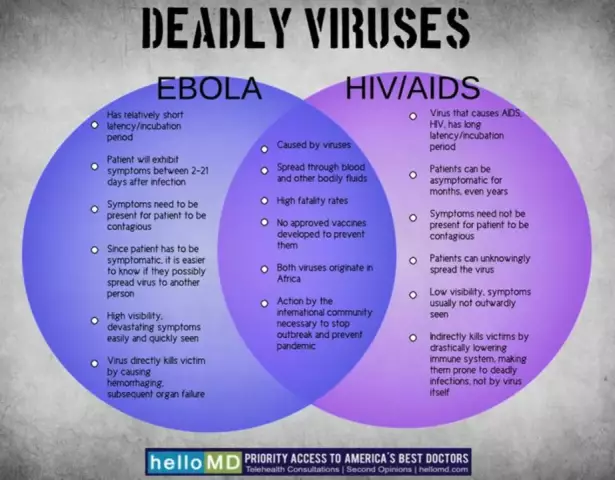- Author Rachel Wainwright [email protected].
- Public 2023-12-15 07:39.
- Last modified 2025-11-02 20:14.
AIDS
General information about the disease

Acquired Immunodeficiency Syndrome (AIDS) is a disease that is considered one of the most terrible and dangerous ills of modern civilization. The increased attention given to AIDS is due to the fact that for many years scientists have not been able to find a cure for the uncontrolled destruction of the immune system. As a result, the fight against AIDS is carried out mainly through the prevention of the disease and the dissemination of information about it among the inhabitants of the Earth.
AIDS is one of those diseases that are said to kill slowly but surely. The causative agent of the infection changes the DNA structure of healthy cells and can persist in the host's body for more than 3 years. Throughout this period, it does not lose its activity and gradually becomes an integral element in the blood. It is with this feature of the virus that researchers associate an extremely high risk of contracting AIDS when using poorly sterilized instruments that have previously come into direct contact with the blood of an infected person. The situation is complicated by the fact that AIDS, the symptoms of which can appear even several years after infection, is characterized by the highest degree of variability. According to this indicator, the disease is ahead of all viruses known to us, including numerous types of influenza.
How can you get AIDS?
Many people think that AIDS patients are deadly to any normal person. In fact, this is absolute nonsense. There are only three ways to "catch" a disease:
- during intercourse with an infected person;
- in the womb, when AIDS is transmitted to the fetus directly through the placenta;
- when contaminated blood has been transfused or has entered the body in some other way, for example, when using poorly processed surgical instruments.
Knowing how the virus is transmitted, it is no longer questionable that the largest number of AIDS cases is registered among drug addicts, who often use one syringe for intravenous injections. Homosexuals are also at risk, since condoms are not used as often in their environment as during intercourse between men and women. To cope with such problems can only be comprehensive prevention of AIDS, aimed at early identification of the infected. With regard to blood transfusion, in recent years this problem has not been so acute, since today any blood donor undergoes a thorough examination for the presence of the AIDS virus. The same applies to the control over the use of surgical instruments, which is becoming more stringent every year.
There are also some exotic ways of transmission of AIDS, but their share in the overall structure of the incidence is negligible, and therefore we will not consider such provoking factors in the framework of one article. We will only mention that you should be especially careful about sexual intercourse without using a condom during your period.
What happens when the immunodeficiency virus enters the bloodstream?
After entering the body, the DNA of the virus comes into contact with the DNA of the host cell. With the help of the enzyme integrase, it is incorporated into its structure, disrupting the normal functioning of healthy organs and tissues. The signs of AIDS do not appear immediately, but the correct diagnosis is possible even in the early stages, since from the very beginning blood cells contain specific genetic material, that is, in fact, they mutate under the influence of the pathogen.
Submitting to the wrong genetic program, cells begin to reproduce various components of the virus, contributing to its spread. A separate role in this process is assigned to the protease enzyme, which can change the envelope of a new element of the virus in such a way that it becomes suitable for transmitting infection to healthy cells. During the propagation stage, a fairly effective fight against AIDS can be carried out, involving the use of protease inhibitors, which deprive the enzyme of its ability to reproduce.
A natural question arises - if scientists know so much about the mechanism of development of AIDS, then why every year new AIDS patients appear on our planet? The thing here is that the pathogen affects not only T-lymphocytes, but also some other cells with a long service life (macrophages, monocytes). In them, he does not show activity and is invulnerable to the activities of known drugs, that is, it is not possible to completely remove AIDS from the body.
AIDS symptoms
Studies that have been conducted in dozens of Western countries over the years have shown that more than one year can pass from the moment of infection to the appearance of the first symptoms of AIDS itself. However, the rate of progression of the disease depends on a variety of factors: the virus strain, the patient's genetic characteristics, his psychological state, standard of living and other reasons. In general, it is possible to quite accurately identify 5 stages of AIDS, the symptoms of which are:
- a sharp deterioration in well-being - manifests itself after two to three months from the moment of infection. Patients have fever, headaches, enlarged lymph nodes, and a rash on the body. This stage usually lasts about 3 weeks;
- the period of carriage of the virus - is almost asymptomatic and often lasts up to 10 years. Signs of AIDS are only mild symptoms, such as swollen lymph nodes;
- stage of generalized lymphadenopathy - characterized by a strong increase in lymph nodes, but does not last long - about three months;
- period of AIDS - associated complex - the symptoms are quite pronounced. AIDS patients suffer from a sharp decrease in body weight, persistent diarrhea, fever, severe cough, various skin disorders;
- the final formation of AIDS - signs of infection appear constantly and rapidly progress, leading, in the end, to death.
Fighting AIDS
As you know, man has managed to control many diseases, but in the case of the AIDS virus, conventional treatments and vaccines do not work. We wrote about the reasons for the failures above. We only add that all existing developments in this area are very expensive and can prevent AIDS only in the early stages, and even then not in all cases. This means that at present the fight against AIDS is carried out only through the dissemination of truthful information among the sick and moral support for people who have become victims of the infection.
Prevention of AIDS

Since the disease is considered incurable, AIDS prevention has a special role to play. Their goal is to prevent cases of mass infection and at least partially control the spread of the disease among the population. In developed countries, informational propaganda gives good results, but in developing countries it does not work because of the illiteracy of people and an elementary rejection of a healthy lifestyle.
In the prevention of AIDS, great importance is attached to measures to prevent the infection of infants from a sick mother. In this direction, scientists have achieved significant success. Several drugs have been developed that reduce the risk of infection of the fetus with AIDS by 15-20%, and their effectiveness is constantly growing. Particularly encouraging is the fact that such therapy is quite inexpensive and accessible even to the poor.
Despite all the efforts being made, the fight against AIDS is far from over. Yes, researchers are working on obtaining a vaccine and fighting the spread of the disease among newborns, however, all the successes in these areas do not answer the most important question - how to finally defeat AIDS? It is possible that in the future, humanity will be able to cope with the virus, but in the meantime, every year more than 70,000 children become orphans due to the fact that their parents die from this terrible disease.
YouTube video related to the article:
The information is generalized and provided for informational purposes only. At the first sign of illness, see your doctor. Self-medication is hazardous to health!






